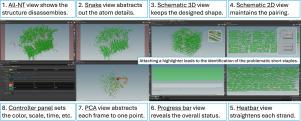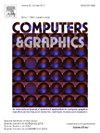SynopFrame: Multiscale time-dependent visual abstraction framework for analyzing DNA nanotechnology simulations
IF 2.8
4区 计算机科学
Q2 COMPUTER SCIENCE, SOFTWARE ENGINEERING
引用次数: 0
Abstract
We present an open-source framework, SynopFrame, that allows DNA nanotechnology (DNA-nano) experts to analyze and understand molecular dynamics simulation trajectories of their designs. We use a multiscale multi-dimensional abstraction space, connect the representations to a projected conformational space plot of the structure’s temporal sequence, and thus enable experts to analyze the dynamics of their structural designs and, specifically, failure cases of the assembly. In addition, our time-dependent abstraction representation allows the biologists, for the first time in a smooth and structurally clear way, to identify and observe temporal transitions of a DNA-nano design from one configuration to another, and to highlight important periods of the simulation for further analysis. We realize SynopFrame as a dashboard of the different synchronized 3D spatial and 2D schematic visual representations, with a color overlay to show essential properties such as the status of hydrogen bonds. The linking of the spatial, schematic, and abstract views ensures that users can effectively analyze the high-frequency motion. We also categorize the status of the hydrogen bonds into a new format to allow us to color-encode it and overlay it on the representations. To demonstrate the utility of SynopFrame, we describe example usage scenarios and report user feedback.

用于分析DNA纳米技术模拟的多尺度时间依赖视觉抽象框架
我们提出了一个开源框架,SynopFrame,它允许DNA纳米技术(DNA-纳米)专家分析和理解他们设计的分子动力学模拟轨迹。我们使用多尺度多维抽象空间,将表征与结构时间序列的投影构象空间图连接起来,从而使专家能够分析其结构设计的动力学,特别是装配的故障案例。此外,我们的时间依赖抽象表示允许生物学家第一次以平滑和结构清晰的方式识别和观察dna -纳米设计从一种配置到另一种配置的时间转变,并突出模拟的重要时期以进行进一步分析。我们将SynopFrame实现为不同同步3D空间和2D示意图视觉表示的仪表板,并使用颜色覆盖来显示氢键状态等基本属性。空间视图、原理图视图和抽象视图的链接确保用户可以有效地分析高频运动。我们还将氢键的状态分类为一种新的格式,以便我们对其进行颜色编码,并将其覆盖在表示上。为了演示SynopFrame的实用性,我们描述了示例使用场景并报告了用户反馈。
本文章由计算机程序翻译,如有差异,请以英文原文为准。
求助全文
约1分钟内获得全文
求助全文
来源期刊

Computers & Graphics-Uk
工程技术-计算机:软件工程
CiteScore
5.30
自引率
12.00%
发文量
173
审稿时长
38 days
期刊介绍:
Computers & Graphics is dedicated to disseminate information on research and applications of computer graphics (CG) techniques. The journal encourages articles on:
1. Research and applications of interactive computer graphics. We are particularly interested in novel interaction techniques and applications of CG to problem domains.
2. State-of-the-art papers on late-breaking, cutting-edge research on CG.
3. Information on innovative uses of graphics principles and technologies.
4. Tutorial papers on both teaching CG principles and innovative uses of CG in education.
 求助内容:
求助内容: 应助结果提醒方式:
应助结果提醒方式:


